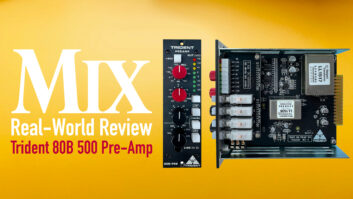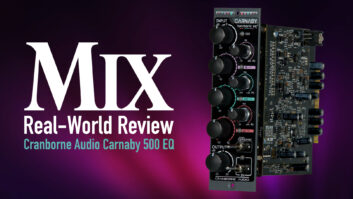I’ve got to give credit to Cranborne for some very effective marketing. Once I read their claims that the Cranborne Audio Camden 500 Mic Amp was an extraordinarily clean mic preamp that can optionally get colorful in two different ways, my curiosity was piqued. Their claim is simple. Transformers offer great common-mode and RF rejection, and they impart often useful non-linearity, but they are not the best way to achieve really open dynamics or flat frequency response. Cranborne’s solution is to employ numerous discrete transistors as gain stages and create two different circuits to emulate a transformer’s tonal behavior.
Real-World Review: Avid Pro Tools Ultimate
Out of the Box
The Camden starts with a detented gain control in approximately 5.5 dB steps ranging from +8 to +63 dB. A three-way toggle switches between mic, line and Hi-Z input (1.5 megohm) with phantom power, polarity reverse and a multistage high-pass filter (-6 dB at 50 Hz) available. This clean path achieves very impressive specs: THD+N of 0.0002 percent, -129 dB EIN (with a 150 ohm load, unweighted), frequency response within +/-1 dB from 5 Hz to 200 kHz at all gain settings (not a misprint), common mode rejection greater than 85 dB (typical) and minimal phase shift of less than 2 degrees from 50 Hz to 20 kHz!
That’s all clean and dandy, but that’s where the two Mojo circuits step in. A series of filters and harmonic generators (2nd and 3rd order) provide Thump or Cream, which aptly describe their respective low- and high-end enhancements. The control knob clicks off for no Mojo at all and then can be cranked from subtle to radical processing beyond typical transformers in either Thump or Cream mode, but not both.
In Session
I first tried out the Cranborne Audio Camden 500 Mic Amp on a bass guitar DI; we already had a nice clean tone and were looking for some growl-y, sustain-y stuff to run in parallel for an edgy rock tone. We had some gritty distortion coming out of an MXR distortion-pedal-DI that sounded only ok until we kicked in the Mojo. Cream was nice but a little forward and top-end-y for this case, but Thump was right on point. At about 75 percent, a very nice thickening and warmth thing kicked in and gave our bass an attitude boost and an emphasis on the lowest two octaves I was looking for.
A drum room with a ribbon or a condenser mic was rather similar to bass DI. I found excellent response dynamically and frequency-wise with both the low gain required via the LDC and the higher gain needed for my AEA ribbon mic. As you’ve probably already guessed, some Mojo only made things better. Mojo can be pretty subtle, so I found myself typically dialing in values above the 12 o’clock position, whether it was the darker, rounding features of Thump (on the LDC) or the excitement-boosting sweetening of Cream (on the ribbon). Following the Camden with some compression helped even more, even though I chose more neutral compression than the colorful stuff I would typically select.
Percussion tracking offers plenty of flexibility, too. A little Thump helped tambourine tracks to smooth out, with high-end softening even if there was no bottom end to enhance. Cajon tracking always finds me with a low and a high mic, and Camden can assist either one. A moderate amount of Thump does wonders for increasing punch and presence of the low-end downbeats, while significant amounts of Cream helped create snare-like excitement of the high-end upbeats.
The same principles applied to kick and snare tracking, with Thump favoring kicks and Cream favoring snares. This wasn’t a hard and fast rule, though, as hard-rocking kicks gained attack and aggressive excitement via Cream, and thin snares benefitted from the fullness and substance of Thump. I never did get to try tom-toms (as I had only one Camden and would need two or three), but I’d bet that some Mojo could make up for deficiencies in drum head selection or even poor technique.
Vocal tracking and overdubbing presented a near confusion of choices, but there were excellent results no matter which path I chose. For starters, I tried Camden on a vocalist who wanted clean linearity and nothing more. That’s what Camden delivered, with nicely open dynamics, plenty of headroom and flat frequency response that made my mics seem fuller than they’ve ever been.
Where things got interesting was backing vocals and stacking. I found myself using all of Camden’s features to create differentiation and variety. Every combination of the high-pass filter, Cream and Thump found a perfect application. Anywhere from subtle on some tracks to profound on others, Camden allowed me to stay in the creative zone and avoid constant repatching (or re-miking) to achieve my multi-textural goals.
Clean guitars are translated perfectly, but dirty guitars seem to cry out for some Mojo. You might need Thump thickening or Cream emphasizing, but either way, you won’t need much (25 to 50 percent) to increase attitude and musicality.
The direct 1/4-inch input sounded exceedingly flat and neutral with both my basses and acoustic guitars—nothing special, but nothing in the slightest bit deficient either; just clean and slightly honky, like the sources. Mojo to the rescue! Cream at 50 to 75 percent added a little beard, plenty of character and sounded almost amp-like for a prominent bass sound and increased mix audibility without adding level. Thump at 75 percent brought the big-bottom depth that sounded almost like an Ampeg SVT and guaranteed a bass player smile.
Acoustic guitar was similar, with a perfectly ok (but slightly nasal) sound sans Mojo. Cream at 50 percent was delightful, with more richness, harmonic overtones and increased presence. Thump at 50 to 65 percent was equally wonderful, with increased fullness, texture and euphony, needing the HPF to reign in the extended bass. Both Mojo settings could turn a scratch guitar DI track into a keeper track if a lack of time or isolation was a problem. Seriously impressive results.
The “negatives” are few and not crucial: more metering beyond a pair of LEDs would be nice, the unit will loudly click/pop with the throwing of a switch (including gain), and a separate Mojo on/off switch would be nifty. I did not miss an output level control or impedance switching due to the inherent flexibilities of the Mojo circuits.
The Final Mix
Don’t confuse the Cranborne Audio Camden 500 Mic Amp with a specialized one-trick-pony generator of dirt and harmonics. It’s more accurately a reference-type preamp with an entirely neutral, linear, flat and open response across all gain settings, and it has breathtaking consistency from all sources. The fact that Camden can also generate harmonics, color and attitude makes it the most versatile preamp I’ve tested. Camden has destroyed my preconceptions about transformers and their necessity, making it a game-changer … especially for only $349.
If you’d like to hear the Camden in action, visit the Cranborne website for informative videos and a slew of audio examples. You can also send Cranborne a WAV file that they will Mojo for you, free of charge.
Cranborne Audio • www.cranborne-audio.com







